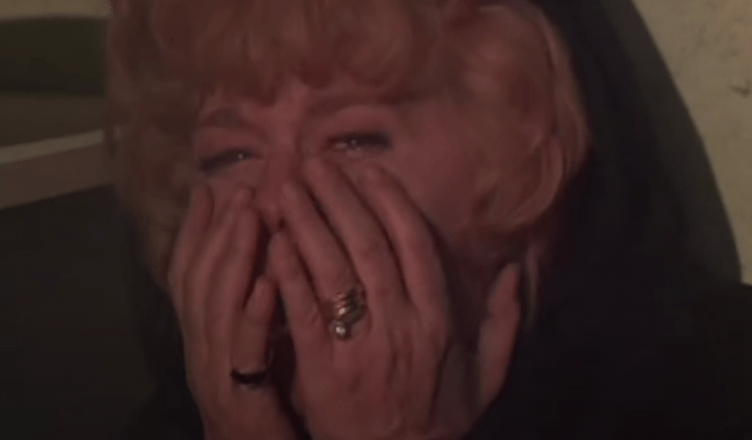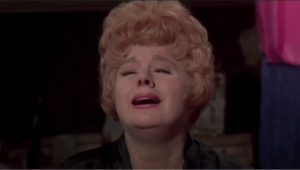Film Deets:
Director: Curtis Harrington
Screenplay: David D. Osborn, Robert Blees, James Sangster, Gavin Lambert
Actress: Shelley Winters
Category: Maternal Grief
Themes: Grief, Psychotic Break
Why do these screams matter?
Typically considered a part of the hagsploitation horror sub-genre, Who Slew Auntie Roo tells the tale of Rosie “Auntie Roo” Forrest (Shelley Winters), a wealthy widow renowned for the annual Christmas party she throws for the local orphans. But her kind demeanor and generous spirit belie substantial mental health issues brought about by the accidental death of a daughter whose mummified remains still reside in the nursery. When Christopher (Mark Lester) and Katy (Chloe Franks), a brother and sister, attend the lavish holiday party, Auntie Roo is taken with Katy’s resemblance to her deceased daughter. Her desire to keep the child with her sets in motion events that ultimately end in tragedy.
What is somewhat unique about this film is the immediacy with which it asks viewers to regard the titular character as dangerously unhinged. Auntie Roo’s actions, such as refusing to relinquish the body of her late daughter, singing lullabies to the corpse, and maintaining the nursery exactly as it was prior to the child’s death, are meant to ensure that the audience reads Auntie Roo as deeply disturbed and thus, the villain of the narrative. As Alexa Wright notes in her exploration of the human monster, otherness becomes “the tangible manifestation of what is considered monstrous” (19). Auntie Roo’s actions, which are not normal by any objective standard, solidify her marginality and are designed to signal a perversion of motherhood that reflects her status not as a “real” mother but as an “other” mother. So, for the audience, Auntie Roo’s aberrant behavior centers her as the film’s central threat almost immediately.
Our first scream occurs early on in the film when Auntie Roo has convened a séance to contact her deceased daughter. The séance is led by the unscrupulous Mr. Benton (Ralph Richardson) and Auntie Roo’s nefarious servants, all of whom are colluding to convince the woman that contact has been made with her late daughter so that they can bilk her out of more money.
Auntie Roo’s scream is a plea to her daughter not to leave and is the film’s first real moment where Auntie Roo’s maternal grief is highlighted. To director Curtis Harrington’s credit, the scene is asking viewers to have a multi-layered and complicated response to Auntie Roo’s grief. On one level, the pain of the character is palpable. And when combined with our understanding that she is being taken advantage of by numerous devious characters, it is a clear invitation to regard Auntie Roo with pity. But the moment also clearly positions the character as unwell, and in horror films, unwell equates with dangerous. Tomasz Fisiak, in writing about Hag Horror as trauma, notes that Auntie Roo’s “over-the top demeanor, hysterical mood swings, reliance on mediums, extravagant theatrical dresses, and grotesque “transitions from faux crying to laughter” (Shelley 185) reinforce her image as a mad woman, thereby placing her in the role of a threatening Other whose trauma directly affects another person” (325). This association is a thread that the film continues to pull at through various scenes depicting Auntie Roo’s precarious mental state. Scenes ranging from her belief that Katy is the reincarnation of her late daughter to her frantic need to prepare dinner in the wake of the corpse’s finally turning to dust illustrate Auntie Roo’s non-normative behaviors. Her turn toward domestic labor in the face of extreme emotional turmoil is especially telling. In the late 1960s, death was a largely isolating experience with minimal to no support structures available to the bereaved (Jalland 16). With no family support or therapeutic options presented to her, Auntie Roo is never presented with the tools or support she needs to fully process her trauma. Her abject inability to separate from her daughter’s corpse illustrates the emotional purgatory in which she exists. Consequently, she reverts to behaviors she and society ascribe to being a “good” mother.
Her singular focus on preparing dinner when confronted with the loss of her daughter’s body plays into the era’s framing of motherhood as self-sacrificial and domestic. In the 1950s, women were cast as the heart of the nuclear family. This narrative was perpetuated largely through media images of the smiling mother/wife who greeted her family with a kind word and a homemade dinner each evening (Haralovich 63). The film present’s Auntie Roo’s attempts at homemaking as compulsive and desperate thereby making her actions read like an uncanny performance of domestication. It is a delusional state highlighted by the scream she releases. The scream itself- a cacophony of grief and desperation- centers Auntie Roo’s vulnerability even as it acknowledges her deviancy positions her as an unusually sympathetic Other.
But if Auntie Roo is truly the film’s monster, then horror film conventions dictate that she must be dispatched to restore order. And that objective informs our next scream in which Christopher, who has seemingly convinced himself that Auntie Roo is the witch from Hansel and Gretel and intends to eat both him and his sister, sets Auntie Roo on fire.
In children’s fairytales, the witch is often dispatched in cruel fashion. The screams Auntie Roo unleashes in this moment certainly function as part of the film’s overt demonization narrative by playing upon this association. The screams heard here are those of a woman who realizes that she is about to die but there is also a distinct wounded quality to them because she realizes that once again, she is being robbed of the ability to mother a child. The fact that Christopher invokes the story of Hansel and Gretel is by design. By using the tale of a sadistic older woman who lives in a house of candy to frame out Christopher’s perception of Auntie Roo, the film is asking us to associate Auntie Roo and her so-called gingerbread house with the villain of the Brothers Grimm fable. It’s a pop-culture form of shorthand that fills in the blanks for the audience, lest we have too much sympathy for the character. It is an especially problematic association since we know that Auntie Roo is not a witch and that she has absolutely no intention of eating the children. Her death stems directly from a misunderstanding of her maternal grief- and the fact that the film asks us to cheer for the children, who are making jokes while the woman burns, and to feel at the same time a sense that justice is being served, excessively demonizes a woman who never deserved to be vilified in the first place.
Works Cited
Fisiak, Tomasz. “What Ever Happened to My Peace of Mind? Hag Horror as Narrative of Trauma.” Text Matters, vol. 9, no. 9, Nov. 2019, pp. 316–327.
Haralovich, Mary Beth. “Sitcoms and Suburbs: Positioning the 1950s Homemaker.” Quarterly Review of Film & Video, vol. 11, no. 1, 1989, pp. 61-83.
Jalland, Patricia. “A Culture of Silent Grief?: The Transformation of Bereavement Care in 20th Century England.” Bereavement Care, vol. 32, no. 1, 2013, pp. 16-22.
Who Slew Auntie Roo?. Directed by Curtis Harrington, performances by Shelley Winters, Mark Lester, Chloe Franks, American International Pictures, 1972.
Wright, Alexa. Monstrosity: The Human Monster in Visual Culture. Bloomsbury Publishing, 2013.







